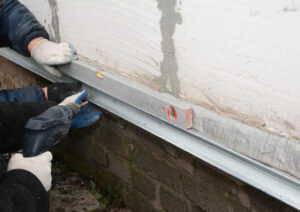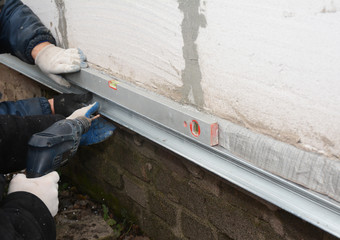The cost of Sugar Land Foundation Repair depends on a few different factors. The first is how many support sections need to be repaired.
Cracks are usually the most obvious sign of foundation problems. They can be small vertical cracks or diagonal ones. If a crack admits water, it is more of an issue. Proper drainage and tree and vegetation management are also important.

It is important to watch for signs of foundation damage to catch them early and take action before they cause extensive and costly problems. These problems include a weak crawl space that can lead to wet furniture and mold, and rotting beams that attract termites. Many of these issues are caused by the soil conditions in a home’s location or by environmental factors. However, a few of them are simply due to improper construction or inadequate maintenance. These problems are often overlooked by homeowners, but they can be prevented with routine inspections and regular foundation repair services.
Some of the most obvious signs of foundation damage are cracks in exterior walls and basement walls. These cracks may appear in a horizontal or vertical pattern and can be a sign of sinking, shifting, or settlement. It is also important to look for cracks that are widened over time, especially if they appear in a zigzag pattern. Cracks that are wider than 1/8 of an inch are also a sign of a serious problem that needs to be addressed immediately.
Other signs of a problem include gaps around doors and windows, crooked door frames, and door and window frames that no longer latch properly. In addition, if you notice that your floors are sagging or uneven, this is another sign of a foundation issue. This happens when the foundation shifts and pulls on the floor, causing it to lose its support.
If you notice a lot of moisture in the crawl space, this is a serious warning sign and should be dealt with immediately. Moisture in the crawl space leads to rot and can destroy your floor joists. It can also attract termites and lead to mold, which can be a health hazard for your family.
It’s also a good idea to look for any signs of a leak in the house, particularly in the basement. This could be a sign of a leaking sewer line or damaged gutters. A wet basement after a rainstorm is also a sign of water damage to the foundation.
When you notice foundation damage, it is important to act quickly. The sooner you get repairs done, the more time your home has to regain stability. Professionals can prevent the problem from getting worse and save you from expensive structural damage in the future. There are many different repair methods that can be used, so it is important to educate yourself on these options and select one that fits your needs and budget.
One of the most common signs of a failing foundation is cracks in the walls and floors. These cracks can be non-structural or structural. Non-structural cracks are a result of expansion and contraction, while structural cracks indicate that the weight of the house is being unevenly distributed. The type of cracks you have will determine what repair method is best for you.
Some repair options include a concrete patch, epoxy injection, and hydraulic cement. These repair methods are quick and inexpensive, but they will only mask the problem rather than resolve it. They can also be dangerous for your family’s health because they do not address the root cause of the problem. If you are concerned about the safety of these repair options, consult with a professional.
Another permanent repair option is piering and slabjacking. This involves digging long steel piers into the ground beneath your home. These piers are then jacked up using hydraulic jacks, which lift your foundation back into place. The piers are then connected to your foundation and fastened, which stabilizes the structure and prevents further sinking.
Piering is more intrusive than other foundation repair methods, but it is a highly effective solution for sinking foundations. This process uses steel piers that are driven into the load-bearing soil much deeper than the concrete foundation can reach. The piers are then tested with more weight than your foundation can hold before being attached to the foundation.
Another popular option for repairing foundations is polyurethane foam jacking. This technique is less invasive than installing a new concrete foundation, and it can usually be completed within a few hours. During this process, technicians will drill strategically placed holes in your foundation and inject high-density foam. The foam will expand within seconds, lifting your foundation concrete. However, this method is not recommended for homes with plumbing since the foam may enter holes in your pipes and solidify inside of them.
If you think your home may have foundation problems, it is important to find a qualified contractor. A good contractor will be able to help you decide whether the problem is serious enough to require repairs, and what repairs are necessary. They will also be able to give you an estimate of the cost of the repairs. It is a good idea to get quotes from several contractors before making a decision.
The type of work that your home needs will influence the price of the repair. For example, if your foundation requires extensive reinforcement, this will be more expensive than patching small cracks. In addition, the size of your home and its location will affect the price. If your home is located on a hill, the foundation will need to be reinforced more extensively than a house in flat land.
Some contractors specialize in a specific type of foundation repair. For instance, a company that only repairs concrete foundations will have specialized tools and equipment that are more likely to be able to diagnose and fix the problem than a general contractor who does not. A specialized contractor will also have the training, knowledge, and experience that are needed to properly complete the work.
You should also look for a company that is licensed and insured. Some states have licensing requirements for contractors, and you should check with your local government to see what the requirements are in your area. Also, look for a company that has affiliations or endorsements from other companies in the industry. These are a good indication that the company is reputable and has a strong track record.
Finally, you should ask the contractor about their methods. Ideally, you want a company that uses minimally invasive methods. These methods will not only reduce your expenses, but they will also minimize disruption to your daily life.
Getting a foundation repair done can be an overwhelming process, but you should take your time and make sure that you hire the right contractor for the job. The last thing that you want is for your foundation damage to worsen in the future because you hired a poor contractor to do the work.
Foundation repair is an investment, but it’s one that pays off in the long run. Ignoring signs of damage can lead to worse problems, costing homeowners more in the future. That’s why it’s important to take the time to find a professional and make the repairs as soon as possible.
The most common signs of a foundation problem are cracks or shifts in the home’s structure and exterior. It’s possible to do some DIY-ing for minor issues, such as filling in small cracks less than one-eighth of an inch wide. But larger cracks should be inspected by a professional. They could indicate a much bigger problem that requires professional repair.
For more severe problems, such as bowing walls, a contractor can use underpinning or hydraulic piering to support the house. These methods can run between $8,000 and $12,000 for a typical home. They can also include the costs of excavation, lifting the house if necessary, and installing the piers.
Other factors that can affect the cost of a foundation repair include soil conditions, landscaping needs, and hidden obstacles in the ground. A structural engineer may need to inspect all unconcealed areas of the basement or crawl space to assess if there are signs of damage and determine the best repair method. This can add another $1,000 to $2,500 to the total cost of the project.
It’s also possible that your home insurance policy will cover the cost of foundation repair. You’ll need to talk with your provider and review your policy details to know if this is an option for you.
If you are unable to afford foundation repair, you may be able to borrow money through a lender or find a company that offers financing options. This can help you avoid further damage to your home and get the work done before it’s too late. While repairing a foundation is expensive, it’s better to do so than allow your home to continue to move and potentially collapse. It’s also an investment that will protect your family’s safety and the value of your home.

